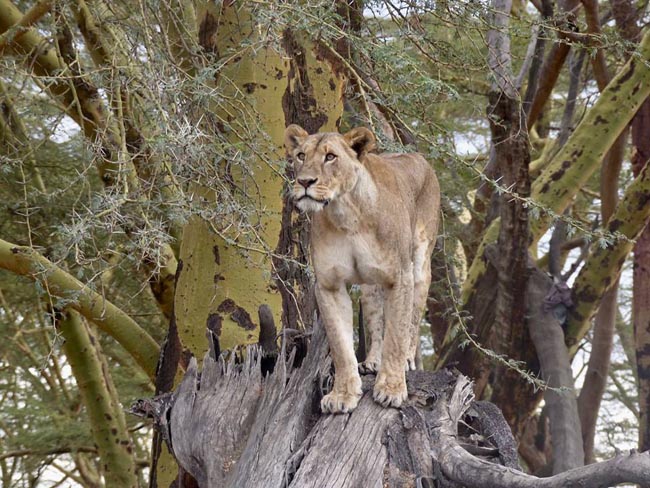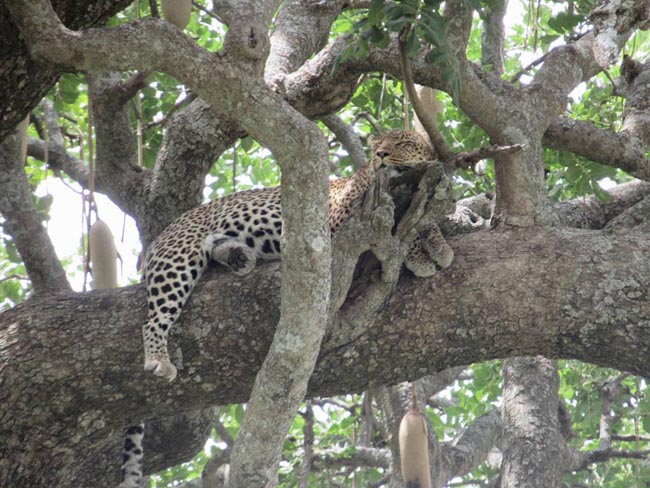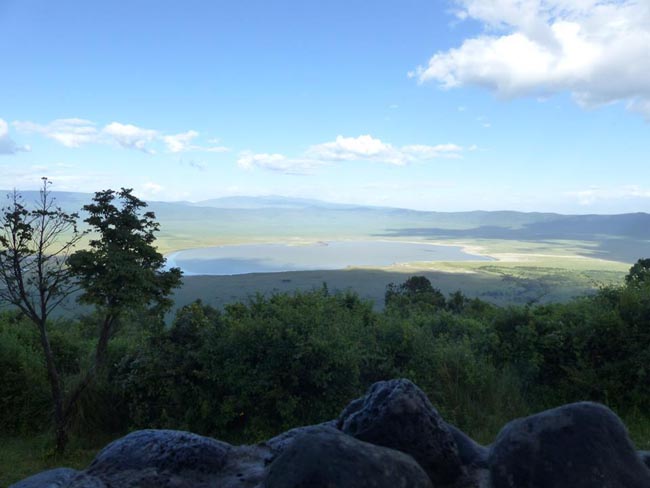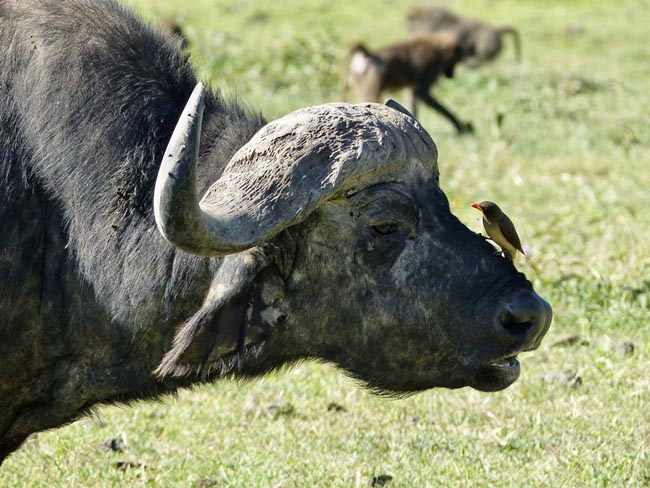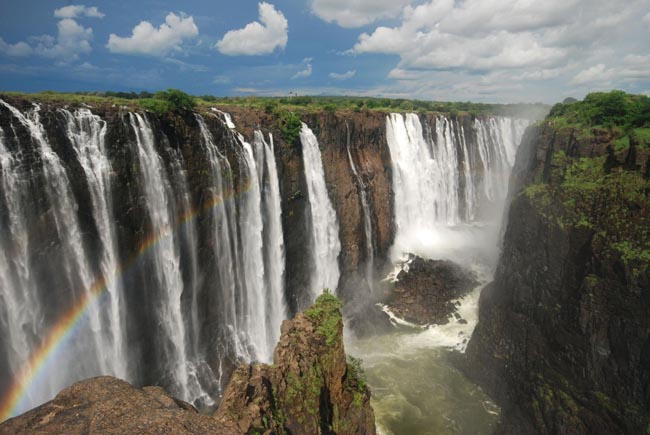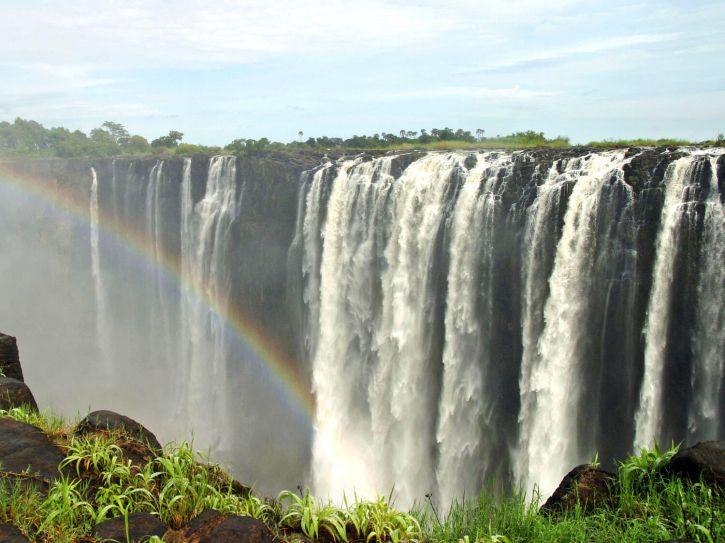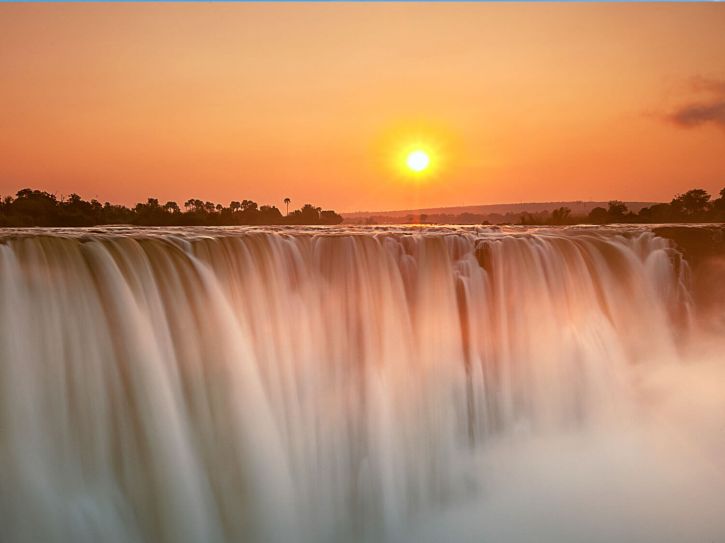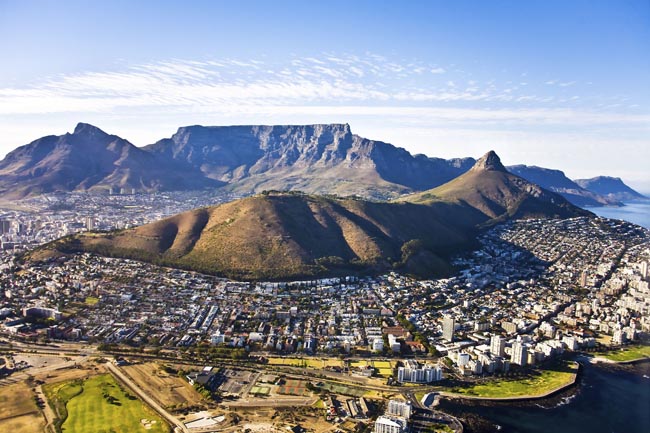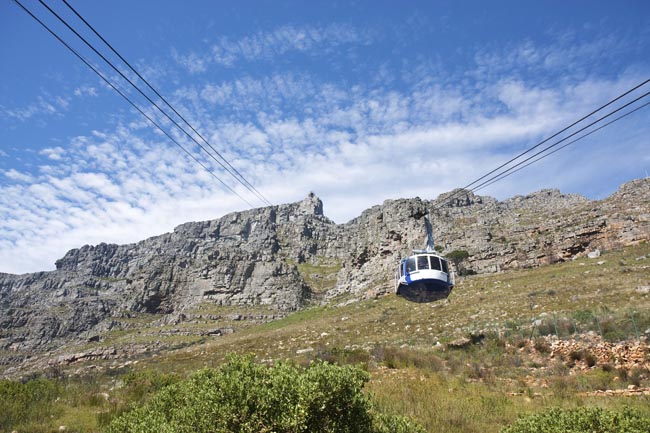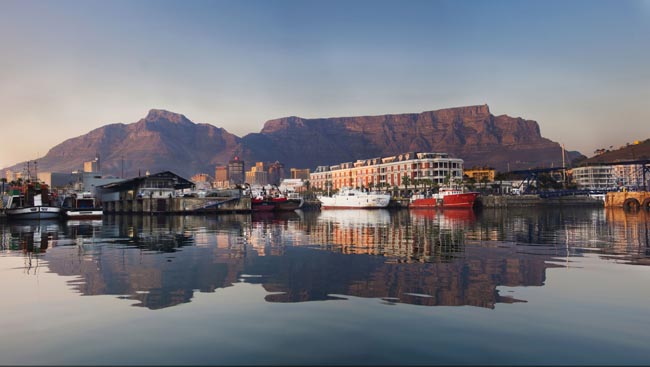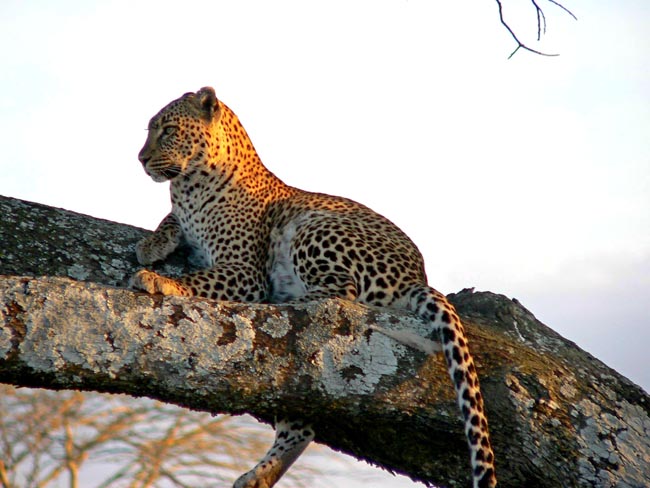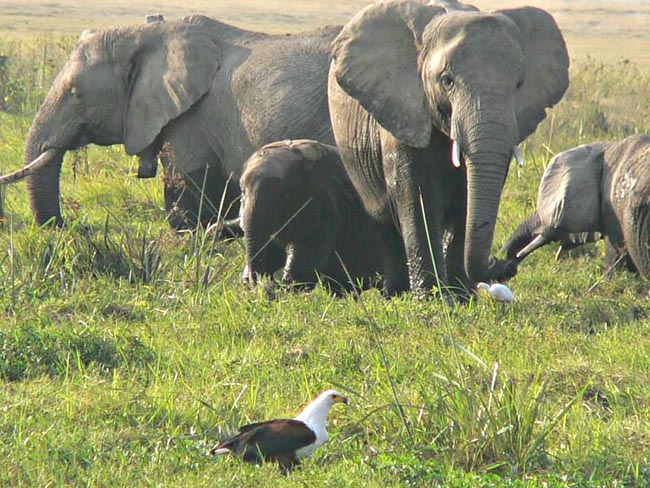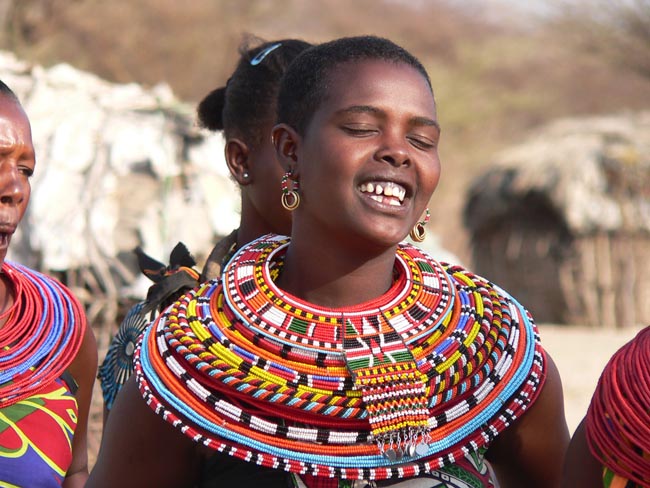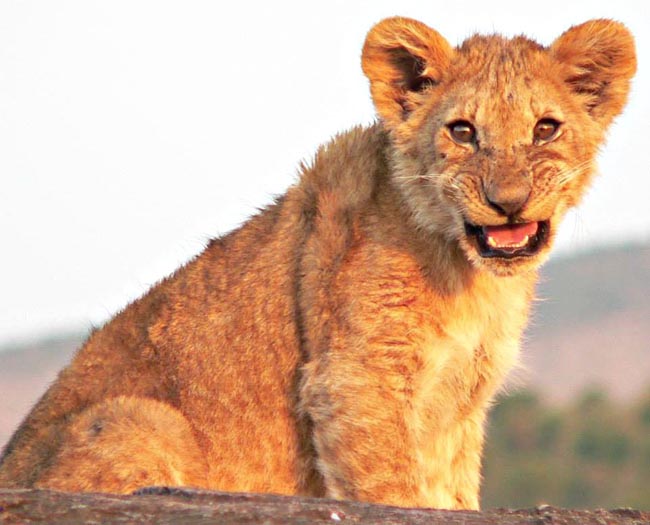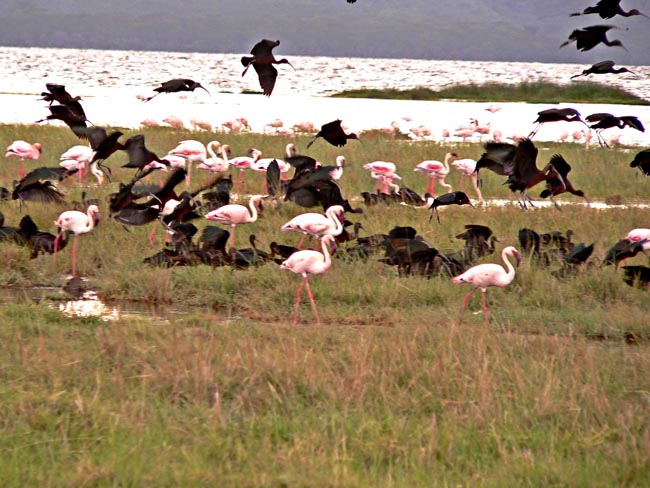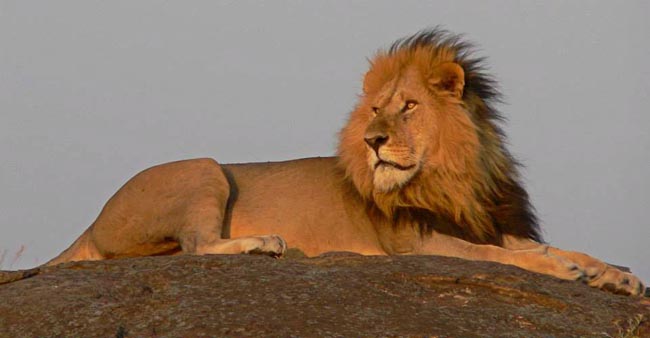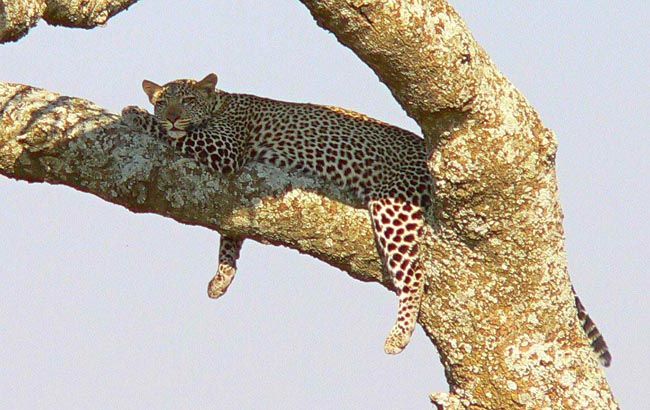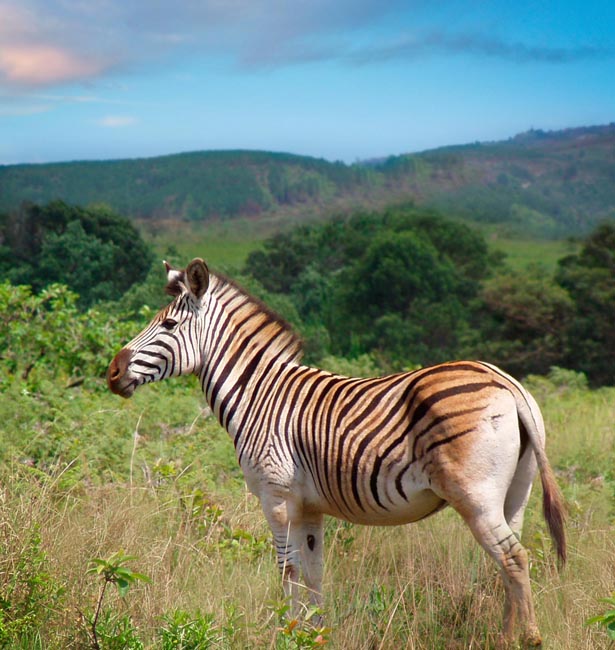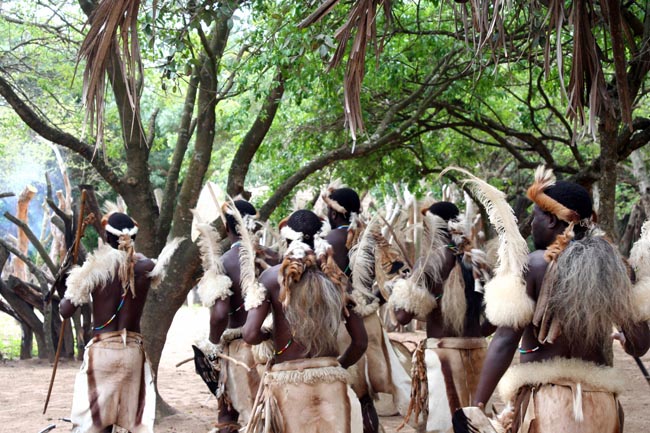Nairobi, Kenya, is our entry point for our Kenya, Tanzania & Southern Africa tour, an adventure through Africa, and we take time to enjoy its pleasant mix of colonial British and modern and traditional influences before heading in the direction of Africa's second-highest mountain; Mount Kenya.
In semi-desert savanna plains at the foothills of the mighty peak, we partake in wildlife safaris that allow close-up views of elephants, giraffes and gazelle and visit tribal villages wherein locals adorned in traditional garments adhere to the long-held customs of their forefathers.
For a fun-packed 33 days through half a dozen countries, we see an astounding array of wildlife, a wide spectrum of spectacular sceneries and incredible diversity of culture and lifestyle.
Visiting world-renowned conservation parks such as Masai Mara National Reserve, Ngorongoro Conservation Area, Chobe National Park, St Lucia Wetland and Kruger and Serengeti National Parks, we see the very best of the natural world in Africa.
We take advantage of unique opportunities to see, among others, the 'Big Five', herds of zebra, wildebeest and giraffe, cheetah, crocodile, hippo, monkeys and teeming birdlife; all the animals that set Africa apart as the ultimate safari destination.
Travelling through some of the most stunning landscapes on the planet - from the barren beauty of the Serengeti Plains, to the enchanting mist-encircled mountains around Mount Kilimanjaro and the forest, woodland, grassland and swamps of Lake Manyara - we cover a broad range of typographical feature and hit all the major tourist-spots, like the fabulous Victoria Falls in Zambia, as well as venturing into the back and beyond for some off-the-beaten-track exploration of the hidden face of Africa.
We learn about the man-made environments of the six highly rewarding destinations with sightseeing in traditional villages, colonial towns and modern metropolises along the way and we immerse ourselves in a number of fascinating cultures to glean an idea of what life in Africa is really like.
Prices below are per person, twin-sharing costs in US Dollars (USD). Pricing does not include airfare to/from the tour and any applicable taxes. For single supplement rates and taxes (if any), please refer to below Prices & Dates table. For general information on flights to/from the tour, click here.
Your Travel and Accommodation Arranged For You
Tips Included for Driver, Restaurant Staff, Local Guides
Authentic Local Experiences With Lots Of Inclusions.
Select a date below to reserve your spot:
The above prices are subject to an additional $359 for taxes/fees levied on flights that occur as part of the tour. The internal airfares ARE included (any exceptions are listed in red below), but we list the taxes separately on your invoice as they are beyond our control and can change at any time.
Upon 'guarantee,' we will require an additional pre-payment of $1000 per person to cover the internal flights included on the tour. Once paid this amount becomes 100% non-refundable & non-transferrable.
Optional Single Supplement: $2830 USD (number of singles limited).
This tour may require a mandatory single supplement charge of $1420 if you join our share program and we are unable to pair you.
Download Itinerary
Day 1 Arrive in Nairobi
Today we arrive in Nairobi, the capital of Kenya.
Part of Maasai land when the British arrived, this modern capital grew with the development of the railway. Derived from a Maasai word meaning "Cold Water," Nairobi is a pleasant mix of colonial British with modern and traditional African influences.
Overnight in Nairobi.
Included Meal(s): Dinner
Day 2 Nairobi - Ol Pejeta Conservancy
Today we travel from Nairobi, through the "White Highlands," so called because of the large number of Europeans who settled here, northwards to the lower slopes of Mt Kenya, rising to 5199 m (16,728 feet), Africa's second highest peak. Our (+/- 4 hour) drive will take us into the Central Highlands, the heartland of the Kikuyu people. This is a very fertile region, well-watered, intensively cultivated, and thickly forested. The land was coveted by the Europeans who began arriving in ever-increasing numbers once the railway through the area was completed. The settlers established coffee and tea plantations on the eastern slopes of Mt Kenya and cultivated wheat on the western slopes.
Our destination is Sweetwaters, a luxury tented camp clustered around a water hole and set in the pristine calm of the private Ol Pejeta Conservancy, a non-profit organization supporting endangered species, tourism and community outreach. Ol Pejeta is East Africa's largest Black Rhino sanctuary, the only place in Kenya to see chimpanzees, and holds some of the highest predator densities in Kenya.
This afternoon we'll enjoy our first game drive within the conservancy.
Overnight at Sweetwaters.
Included Meal(s): Breakfast, Lunch and Dinner
Not finding what you're looking for?
Our specialists can take away the stress and create a private custom tour tailored to your exact interests and budget.
Day 3 Ol Pejeta Conservancy
Ol Pejeta Conservancy is a sprawling landscape, a mosaic of diverse habitats stretching across over 350 square kilometers. Imagine rolling grass plains, interspersed with wooded grasslands, acacia woodlands, and patches of dense evergreen thickets – all contributing to a rich and varied ecosystem. This diversity of habitats supports an astounding variety of animals, including, of course, the iconic "Big Five" – lion, leopard, elephant, rhino, and buffalo.
Today, we'll immerse ourselves in this wildlife haven with both morning and afternoon game drives, maximizing our chances of encountering its incredible inhabitants. But that's not all! We'll also have the unique opportunity to visit the Sweetwaters Chimpanzee Sanctuary, a truly special place. This sanctuary is the only one of its kind in Kenya, providing a refuge for the highly endangered and remarkably intelligent chimpanzee species. These chimpanzees, often orphaned or rescued from abusive situations in West and Central Africa, find a safe and nurturing home here. The sanctuary's dedicated staff carefully nurses them back to health, allowing them to live out their days in the security of a vast, natural enclosure. It's a chance to witness these fascinating primates up close and learn about the important conservation work being done to protect them.
Overnight at Sweetwaters Camp.
Included Meal(s): Breakfast, Lunch and Dinner
Day 4 Ol Pejeta - Great Rift Valley - Lake Nakuru National Park
This morning we travel to Lake Nakuru, a shallow soda lake in the Rift Valley (+/- 5 hours). The Rift Valley was created millions of years ago under the strain of enormous volcanic eruptions which resulted in a giant split in the earth's surface from Syria to Mozambique. Lava flowed into the valley, forming escarpments on either side of the gigantic trough which can be up to 80 km (50 miles) wide, big enough to be visible from space. At the lake, depending on the water levels, we may have the opportunity to see flamingos,* in addition to the over 340 species of birds that have been recorded in the Rift Valley!
Lake Nakuru is very shallow and can fluctuate up to five metres (12 feet) each day. When the water is low, you can see a white band of crystallized soda along the shoreline. This is also one of the best places in Kenya to view the rare White Rhino as we explore the park on our afternoon game drive.
* This, and other Rift Valley lakes, have been known in the past for huge numbers of flamingos; however, this can be very "hit and miss" owing to seasonal variations in rainfall and water level, and the increasing frequency of drought. The best we can do is hope for the best!
Overnight in Lake Nakuru National Park.
Included Meal(s): Breakfast, Lunch and Dinner
Day 5 Lake Nakuru - Maasai Mara National Reserve
We rise early this morning and bid farewell to Lake Nakuru National Park, continuing our journey through the dramatic landscapes of the Great Rift Valley. Our route takes us past the serene beauty of Lake Naivasha and the imposing presence of nearby Mount Longonot. This relatively young volcano serves as a stark reminder of the Rift Valley's turbulent geological history. After a drive of approximately six hours, which includes a stretch on a less-than-perfect road, we'll arrive at our lodge nestled within the world-renowned Maasai Mara National Reserve, just in time for a well-deserved lunch.
The Maasai Mara is essentially a seamless extension of the vast Serengeti ecosystem, and it boasts an astonishing concentration of wildlife. This reserve is home to the largest population of lions in all of Kenya, a testament to its rich biodiversity. Large herds of plains game roam freely across the Mara's grasslands, creating a spectacle of nature at its finest. The Maasai Mara is also arguably the best place in Kenya to spot cheetahs, those sleek and graceful hunters.
Later this afternoon, we'll embark on another thrilling game drive, venturing out into the reserve in search of its incredible inhabitants. The possibilities are endless, and every game drive offers a unique and unforgettable experience.
Time permitting, we may have the opportunity to visit a local Maasai village. This cultural immersion would provide a fascinating glimpse into the Maasai people's traditional way of life, allowing us to meet its residents and learn about their customs and beliefs. If time constraints prevent us from visiting the village today, we'll make every effort to arrange this experience on our return journey to Nairobi.
Overnight in the Maasai Mara.
Included Meal(s): Breakfast, Lunch and Dinner
Day 6 Maasai Mara National Reserve
The Maasai Mara National Reserve, a seemingly endless expanse of rolling grasslands, sits at the northern edge of the vast Serengeti Plain. Widely regarded as Kenya's premier park, the Mara plays a crucial role in one of nature's greatest spectacles: the annual wildebeest migration. These massive herds journey north from Tanzania around the end of June, gracing the Mara with their presence before returning south around the end of September. This incredible movement of animals is a sight to behold.
"The Mara," as it's affectionately known, is a haven for wildlife, supporting all of the famed "Big Five" – lion, elephant, leopard, rhinoceros, and buffalo. Beyond these iconic creatures, the reserve teems with an astonishing abundance of herding animals, including zebras, gazelles, and antelopes, as well as a rich diversity of other wildlife. As you traverse the reserve, you'll likely encounter the stately Maasai men and youth, easily recognizable by their distinctive attire, tending to their cattle and goats along the roadside. Their presence adds a unique cultural dimension to the Mara's natural beauty.
Today we've dedicated a full day to exploring this remarkable reserve, with both morning and afternoon game drives planned. This will give us ample opportunity to witness the incredible wildlife that calls the Maasai Mara home, from the majestic predators to the vast herds of herbivores, and everything in between. Every game drive in the Mara is a unique adventure, filled with the potential for unforgettable encounters.
In the Mara you will also have an optional opportunity to ascend over the northern Serengeti at daybreak in a hot air balloon (optional expense). From over 300 m (984 feet) above, you will be able to view the vast land and the myriad animals that inhabit the Maasai Mara. Today or tomorrow are the best days to participate in this activity - details sent upon booking.
Overnight in the Maasai Mara National Reserve.
Included Meal(s): Breakfast, Lunch and Dinner
Day 7 Maasai Mara National Reserve
We enjoy another full day with game viewing in Maasai Mara. Depending on the season and current game locations and viewing conditions, we may divide our day into morning and afternoon drives, or take our lunches with us in order to venture further into the reserve if conditions warrant.
Overnight in the Maasai Mara National Reserve.
Included Meal(s): Breakfast, Lunch and Dinner
Day 8 Maasai Mara - Nairobi
After breakfast, we'll embark on our journey back to Nairobi. The drive itself is expected to take approximately six hours, factoring in comfort stops along the way.
A highlight of our return journey will be a visit to the Karen Blixen Museum, conveniently located just outside of Nairobi. This isn't just a quick photo opportunity; we'll delve into the fascinating story of Baroness Karen Blixen-Finecke. Imagine stepping back in time to the 1920s and 30s – this Danish Baroness made Kenya her home in 1918 and lived here until 1931. It was during this period that she drew inspiration for her most famous work, "Out of Africa," published in 1937 under her pen name, Isaac Dineson.
The museum itself is Blixen's beautifully restored former home. It offers a unique glimpse into her life in colonial Kenya, showcasing the style and furnishings of the era. As we tour the house, we'll learn about her struggles and triumphs, her relationships, and the profound connection she felt to the African landscape. It's a chance to connect with the author behind the iconic book and gain a deeper understanding of the historical context that shaped her writing.
We'll make a lunch stop in the vicinity before continuing to our Nairobi hotel.
Overnight in Nairobi.
Included Meal(s): Breakfast and Dinner
Day 9 Nairobi - Amboseli National Park
Our adventure continues today as we journey south from the bustling city of Nairobi to the breathtaking Amboseli National Park. The drive is estimated to take around four hours, though this can vary slightly depending on the specific location of our lodge within the park and, of course, the wildlife we encounter along the way. Keep your eyes peeled – you never know what surprises the African bush might have in store!
Amboseli National Park boasts a truly spectacular setting. Straddling the border with Tanzania, it lies on the vast African plain, offering unparalleled views of the majestic Mount Kilimanjaro. Towering above the landscape at a staggering 5894 meters (19,300 feet), Kilimanjaro is the highest peak on the entire African continent. Its iconic, snow-capped cone often appears to float ethereally above the shimmering plains, creating a truly awe-inspiring vista.
Amboseli is renowned worldwide for its thriving populations of elephants. These magnificent creatures roam freely across the park's open grasslands, often dusting themselves with the distinctive red soil, which gives their skin a particularly dramatic, almost ochre hue. This afternoon, we'll embark on a game drive within Amboseli. Picture this: herds of elephants grazing peacefully on the open plains, with the colossal Mount Kilimanjaro providing a picture-perfect backdrop. We'll be on the lookout for other incredible wildlife as well, but the chance to witness these gentle giants in their natural habitat, with such an iconic mountain as a witness, is an experience you won't soon forget (weather permitting, of course – Kilimanjaro can sometimes be shy behind the clouds!).
Overnight in the Amboseli National Park.
Included Meal(s): Breakfast, Lunch and Dinner
Day 10 Amboseli, Kenya - Lake Manyara National Park, Tanzania
Our Tanzanian adventure begins this morning as we cross the border from Kenya into Tanzania at Namanga. From there, we'll journey onwards to Lake Manyara National Park, passing through the vibrant town of Arusha. Arusha serves as the gateway to Tanzania's renowned northern safari circuit, and it's a bustling hub of activity. Our total travel time today is expected to be around five hours, though the border crossing itself can also sometimes take a little time.
Lake Manyara National Park, though the smallest of the northern Tanzanian parks at 330 square kilometers (two-thirds of which is the lake itself), packs a big punch in terms of biodiversity. Its diverse vegetation ranges from open savannah grasslands to lush groundwater forests and vital riparian habitats, creating a rich tapestry of ecosystems. The lake is a haven for birdlife, most notably thousands of pelicans, ibis, and flamingos. Their calls and vibrant colours create a spectacle that can be experienced even from a distance.
After lunch at our lodge, we'll embark on an e afternoon game drive within Lake Manyara National Park. The park's location at the base of the dramatic Great Rift Valley escarpment adds to its scenic beauty. Its diverse landscape, encompassing forests, woodlands, grasslands, and swamps, provides habitat for a wide array of wildlife. While the birdlife is undoubtedly a major draw, the park also boasts a healthy population of other animals. We'll be on the lookout for buffalo, elephants, graceful giraffes, impalas, hippos, and a fascinating variety of smaller creatures.
Overnight at Lake Manyara.
Included Meal(s): Breakfast, Lunch and Dinner
Day 11 Lake Manyara - Serengeti National Park
This morning we embark on a scenic journey into the renowned Ngorongoro Conservation Area. This protected area boasts a stunning, rolling landscape, offering periodic, breathtaking glimpses of the Ngorongoro Crater itself. Before we make our descent onto the seemingly endless Serengeti Plain, we'll pause at a designated viewpoint to fully appreciate the sheer scale and beauty of the crater.
The very name "Serengeti" is derived from the Maasai language, meaning "Land-without-end," and it's a fitting description. This is a place of superlatives, where the vastness of the landscape is matched only by the incredible biodiversity it sustains.
Our journey today, including our game drive, will take approximately five hours, though this can vary depending on the wildlife we encounter along the way and the location of our lodge within the Serengeti. This afternoon's game drive will serve as a wonderful introduction to this remarkable landscape and the diverse array of animals that call it home. Our guides will help us spot and identify the various species, sharing their knowledge of the Serengeti ecosystem and the intricate relationships between its inhabitants.
Overnight in the Serengeti National Park.
Included Meal(s): Breakfast, Lunch and Dinner
Day 12 Serengeti National Park
Today we have a full day of game viewing on the Serengeti. We will visit the "kopjes," a series of low, incongruous hills dotting the open landscape that often provide a vantage point for hungry predators contemplating the endless stream of hoofed animals parading past them. Depending on the season and the timing of the rains, up to 1.5 million wildebeest and a half a million zebra embark on a single-minded and perilous quest for water and grazing land. Following this spectacle, of course, are the meat-eating opportunists, hoping to capitalize on the physical toll this journey exacts on the desperate grazers. Even outside of "migration" time, large herds are still seen as they bear their young and feed, gaining strength for their annual return to the park's northern reaches. Resident species that do not migrate make for rewarding animal viewing in any season.
It may be possible to take an optional hot-air balloon safari over the plains at daybreak; today is the best day to participate in this activity -- details will be sent sent upon booking.
Overnight in the Serengeti National Park.
Included Meal(s): Breakfast, Lunch and Dinner
Day 13 Serengeti - Olduvai Gorge - Ngorongoro Conservation Area
Travelling back to Ngorongoro today we make a stop at Olduvai Gorge, site of the Leakey excavations in the 1960s and 70s that established this region as the prehistoric habitat of some of the earliest species of hominids with some finds dating back 1.8 million years. Experts in the life sciences have argued that the Olduvai contribution to the story of human origins remains unsurpassed by any other prehistoric site in the world. A small museum on site outlines the unique geological and human history of the area.
Called the 'eighth wonder of the world' and stretching across some 8300 sq km, the Ngorongoro Conservation Area boasts a blend of landscapes, wildlife, people and archaeology that is unsurpassed in Africa. The volcanoes, grasslands, waterfalls and mountain forests are home to an abundance of animals and to the Maasai. Ngorongoro Crater is one of the world's greatest natural spectacles and its magical setting and abundant wildlife never fail to enthral visitors. Depending on road conditions, gorge stop, animal sightings, and lodge placement, this journey can be 5-6 hours.
Overnight in the vicinity of Ngorongoro Conservation Area.
Included Meal(s): Breakfast, Lunch and Dinner
Day 14 Ngorongoro Conservation Area
Today promises an unforgettable experience as we embark on a half-day tour within the magnificent Ngorongoro Conservation Area, a designated UNESCO World Heritage Site. After an early breakfast to maximize our time, we'll descend into the heart of the Ngorongoro Crater, a truly breathtaking natural wonder. This massive caldera, spanning 20 kilometers (13 miles) in diameter and boasting walls reaching 700 meters (2,300 feet) high, is a microcosm of African wildlife.
The crater floor is a diverse ecosystem teeming with life, and our game drive will take us through this incredible setting. We'll be on the lookout for the famed "Big Five" – lion, leopard, elephant, rhino, and buffalo – any sighting of which is always a thrill. But the crater is also home to a plethora of other fascinating creatures. eep your eyes peeled for herds of wildebeest, graceful gazelles, zebras with their distinctive stripes, and lumbering hippopotamuses. Adding to the spectacle, thousands of vibrant flamingos often gather on Lake Magadi, creating a stunning display of colour against the backdrop of the crater walls.
* In order to reduce congestion and stress on wildlife, the Tanzanian government limits visitors to half-day visits of the crater. Depending on what time "window" we are assigned, our excursion may take place first thing in the morning, or later in the afternoon (both of which are equally advantageous for game viewing, given the relatively mild climate at this altitude).
Overnight in the vicinity of Ngorongoro Conservation Area.
Included Meal(s): Breakfast, Lunch and Dinner
Day 15 Ngorongoro - Gibb's Farm - Arusha
This morning we begin our descent from the Ngorongoro Highlands, retracing our route back towards Arusha. Our journey includes a delightful lunch stop at the charming Gibb's Farm. This unique establishment has a fascinating history, having been founded during the German colonial era. Still privately owned today, Gibb's Farm operates as a small, boutique hotel nestled on the outer slopes of the Ngorongoro Highlands. Surrounded by verdant coffee plantations, the farm offers breathtaking, sweeping views of the lush and beautiful agricultural landscape that stretches out before it. It's a perfect spot to relax, enjoy a delicious meal, and soak in the tranquility of the surroundings.
As we continue our drive, we'll once again pass through the bustling town of Mto Wa Mbu, which translates to "Mosquito Creek." This vibrant town is known for its lively and cosmopolitan atmosphere, a melting pot of cultures and traditions. It's also famous for its distinctive red bananas. These intriguing fruits, while tasting very similar to regular bananas, are a visual treat with their startlingly bright red skins.
We arrive back in Arusha later this afternoon.
Overnight in Arusha.
Included Meal(s): Breakfast, Lunch and Dinner
Day 16 Arusha, Tanzania - Johannesburg, South Africa
Today we fly from Arusha to Johannesburg, South Africa.
NOTE: Depending on flight schedules, we may have to travel to Nairobi and fly to Jo'burg from there. Final arrangements will be advised closer to departure.
Overnight in Johannesburg.
Included Meal(s): Breakfast and Dinner
Day 17 Johannesburg, South Africa - Fly to Victoria Falls, Zimbabwe
Today we fly from South Africa to Zimbabwe where we will spend three nights next to one of the world's most spectacular natural sights, Victoria Falls.
This area has actually been inhabited for hundreds of thousands of years. The first known name of the falls was "Shongwe"; the current name did not come into being until the Scottish missionary and explorer David Livingstone was brought to the falls in 1855 and named them after Queen Victoria. The falls and the nearby town of Victoria Falls are on the mighty Zambezi River, the fourth longest in Africa, forming the border with neighbouring Zambia.
After settling into our hotel, we'll travel by road a short distance to the Zambezi River on which we will enjoy a scenic sunset cruise above the falls. The river here is wide and slow moving; be on the lookout for hippos, elephants, antelope, giraffe and myriad bird species for which the region is famous. After our cruise we will enjoy a lively demonstration of traditional African dancing and drumming before our evening meal.
NOTE: Due to logistical reasons, the order of Victoria Falls area sightseeing activities may vary at the discretion of your Tour Leader.
Overnight at Victoria Falls.
Included Meal(s): Breakfast and Dinner
Day 18 Victoria Falls: Falls Tour & Leisure Time
Today we have a guided walking tour of Victoria Falls and adjacent national park.
Mosi-oa-Tunya ("The Smoke That Thunders") is one of the most amazing sights in the world: twice as high as Niagara Falls and several times longer. It took thousands of years of erosion for Victoria Falls to appear as and where it does now. During the Jurassic Period (150-200 million years ago), volcanic activity resulted in thick basalt deposits covering large parts of Southern Africa. As the lava cooled and solidified, cracks appeared in the hard basalt crust, which were filled with clay and lime. Erosion and the course of the mighty Zambezi River cut through these softer materials, forming the first of a series of waterfalls.
Our tour is conducted on level paved paths, much of which is shaded by the dense rainforest that exists due to spray from the falls. To walk to the farthest extent, with viewpoints along the way, is about one kilometre, the last part of which is without shade. We encourage you to go right to the end, as the views are fantastic, including the best look at the famous Victoria Falls Bridge, the brainchild of Cecil Rhodes, part of his grand and unfulfilled Cape to Cairo railway scheme, even though he never visited the falls and died before construction of the bridge began.
The afternoon is yours to enjoy optional activities. You may relax by the pool, do some shopping in the village famous for local artisan crafts, travel to the Zambian side of the falls or even go sightseeing by micro-light aircraft or helicopter. Your Tour Leader can help plan your afternoon.
Overnight in Victoria Falls.
Included Meal(s): Breakfast and Dinner
Day 19 Victoria Falls, Zimbabwe: Day Trip to Chobe Park, Botswana
Today we make an early morning excursion into Botswana to visit Chobe National Park, located only 1.5 hours by road from Vic Falls. We complete Customs and Immigration formalities and continue with a fifteen-minute drive to the lodge that we will be using as a base for today's activities.
Our safari starts with a cruise on the Chobe River (shade and refreshments available) that takes us close to the waterfowl and wildlife on the river. Large flocks of birds, big pods of hippos and very large crocodiles can be viewed from the safety of your boat.
Our lunch (included today) is served back at the lodge overlooking the river.
After lunch we board open (covered) safari vehicles and head off into the park to view some of the 70,000 local elephants, buffalo herds, sable, wildebeest, giraffe, and with luck, some resident lion and hyena. We travel back to Zimbabwe, arriving at about 18:00.
Overnight in Victoria Falls (dinner on your own this evening).
Included Meal(s): Breakfast and Lunch
Day 20 Victoria Falls, Zimbabwe - Fly to Johannesburg, South Africa
Today we fly from Victoria Falls to Johannesburg (flight times are variable).
Overnight in Johannesburg (Sandton).
Included Meal(s): Breakfast and Dinner
Day 21 Johannesburg & Soweto
This morning we have a tour of the city of Soweto.
Soweto unto itself is actually one of the largest cities in Africa with an estimated population of two million. It also has one of the most dubious histories of any city in Africa, as it was the site of some of the more infamous events during the struggle against apartheid. The name "Soweto" simply stands for South Western Township, due to its location outside Johannesburg. It was here that thousands of black workers were forced to live in order to provide labour for the gold mines.
We will see the good, the bad, and the ugly of Soweto -- from affluent neighbourhoods to shanty towns, one of the world's largest hospital, Baragwanath; and the former homes of Soweto's Nobel Laureates, Desmond Tutu and Nelson Mandela. We also visit the Hector Pietersen memorial where we will learn of the 1976 Soweto Uprising.
A compelling highlight of our day is our visit to the extraordinarily powerful Apartheid Museum, an obligatory stop for visitors and residents alike. The large blown-up photographs, metal cages and numerous monitors with continuous replays of apartheid scenes will make you feel that you were in the townships in the 70s and 80s, dodging police bullets or teargas canisters, or marching with thousands of school children.
We'll also be able to have a panoramic view of central Johannesburg before circling back around to Sandton and our hotel.
Overnight in Johannesburg (Sandton).
Included Meal(s): Breakfast and Dinner
Day 22 Johannesburg - the 'Panoramic Route' - Hazyview
From Jo'burg we head off through the vast wilderness of Mpumalanga (formerly the Eastern Transvaal), the "Land of the Rising Mist". Along the way we travel from the vast grasslands of the High Veld, with its huge farms and ranches, down to the drier Low Veld region characterized by rocky hills and acacia scrub forest. This is an expansive landscape of mountains, valleys, rivers, waterfalls, primal forests, and colourful flora. Steeped in a history of pioneers and fortune-seekers, we will pass many Gold Rush towns and farming communities en route. Lydenburg ("town of suffering") established by Voortrekkers in 1849 lies at the bottom of Long Tom pass. This pass, named after the big gun used by the Afrikaners during the Anglo Boer War, is one of the most scenically dramatic in the country. It links Sabie on the escarpment with Lydenburg on the Drakensberg plateau.
A highlight of our sightseeing today is the spectacular Blyde River Canyon. This great escarpment is the kind of place where brochures and guide books run out of original adjectives to describe the fresh mountain scenery and magnificent panoramic views. The Blyde River Canyon is one of the most spectacular in Africa and its cliffs rise between 600-800 m (2,000-2,640 feet) from the river bed. At the "Three Rondavels viewpoint" is an unforgettable view of three huge rock spirals rising out of the far wall of the canyon. Their tops appear to have a hut-like rounded roof.
We also stop at the nearby Bourke's Luck Potholes, the result of decades of swirling eddies of water where the Treur River meets the Blyde River. The tumult has caused extensive water erosion over time; the result is a series of cylindrical rock sculptures that look as though they would be more comfortable on the moon.
From here we continue to Hazyview near Kruger National Park.
Overnight in Hazyview.
Included Meal(s): Breakfast and Dinner
Day 23 Kruger National Park
Early this morning we enter South Africa's largest game reserve, Kruger National Park, named after Paul Kruger, the first to initiate the setting aside of this area as a reserve in the 1890s. Here we transfer to open safari vehicles and make a full-day excursion through the southern sector of this fascinating and beautiful park.
The Kruger Park is an enormous area of flat veld, broken by rivers and comprised of mixed vegetation and terrain. The park, officially founded in 1926, supports more species of wildlife than any other African reserve -- over 137 mammal species, 49 fish species, 112 reptile species, and nearly 500 bird species! With some luck we may see and photograph lion, leopard, cheetah, elephant, zebra and many other wonderful African animals.
We return to Hazyview in the late afternoon.
Overnight in Hazyview.
Included Meal(s): Breakfast and Dinner
Day 24 Hazyview, South Africa - Mbabane, Eswatini (Swaziland)
We travel south today en route to the Kingdom of Eswatini (formerly Swaziland), an independent country completely landlocked by South Africa and Mozambique, and smaller than Kruger Park! Just before we cross the border, however, we'll visit the Matsamo Cultural Village, a traditional Swazi village that showcases the country's rich cultural heritage. We'll take a guided tour of the village, learning about the customs and traditions of the Swazi people. We'll also enjoy a traditional lunch and have the opportunity to interact with the villagers. This visit will provide a unique glimpse into Swazi culture and daily life.
As we enter the Kingdom of Eswatini, we'll be struck by the country's natural beauty, with majestic mountains forming a stunning backdrop to our journey. One of the last remaining monarchies in Africa, Eswatini offers a unique glimpse into traditional African culture, where the pace of life is relaxed and the lifestyle remains largely unchanged. As we make our way to the vicinity of Mbabane, the capital city, we'll pass through picturesque rural landscapes, where we'll see local people tending to their farms and herds, living in harmony with the land. This tranquil scenery provides a serene introduction to the country's rich cultural heritage.
Before arriving at our hotel, we'll visit the renowned Ngwenya Glass, a pioneering glassblowing institution that has been creating exquisite glass art since the 1980s. Founded as a Swedish aid initiative, Ngwenya Glass has evolved into a thriving enterprise that not only produces stunning glassworks but also supports local conservation programs. What's more, all of the glass art is crafted from 100% recycled glass, reflecting the organization's commitment to sustainability. We'll hope to have the opportunity to witness the skilled artisans at work, shaping and blowing glass into intricate and beautiful forms.
Overnight in/near Mbabane.
Included Meal(s): Breakfast and Dinner
Day 25 Mbabane, Eswatini - Mkuze Game Reserve, South Africa
This morning we depart our hotel and travel south, descending onto the Swazi Lowveld (lowlands), similar in climate and vegetation of the lowveld region we experienced in South Africa and Kruger Park in previous days. Before leaving the kingdom, we'll visit Swazi Candles, a candle making manufacturer both of both traditional parafin wax as well as 100% organic soya candle tea lights. The colourful, handmade product range also features wax encased LED lights, pure vegetable glycerine soaps, and marula oil bodybalm. Guests are invited to interact with the artisans as they work their magic.
We'll then travel through sugar cane plantations and the bustling commercial centre of Manzini, before crossing the border back into South Africa and the province of KwaZulu-Natal.
Our destination is Mkuze Game Reserve, which boast an exceptional variety of natural habitats: from the Eastern slopes of the Lebombo Mountains along its eastern boundary, to broad stretches of acacia savannah, swamps and a variety of woodlands and riverine forest. A rare type of sand forest also occurs in the reserve. It is renowned among ornithologists, with more than 420 different bird species on record. The Mkuze River curves along the game reserve's northern and eastern borders with a stretch of fig forest along its banks. Fish eagles swoop over the pans, snatching prey spotted from their perches in the fever trees.
Mkuze is overlooked by Ghost Mountain, previously a historic battle field. This mountain is said to be the tombs of the previous chiefs of the mountain and, according to legend, it has been the scene of a number of bloody fights. With its dramatic silhouette, in the shape of an old woman or witch head, it is not difficult to understand why the mountain is said to be haunted and to be the theatre of paranormal activities.
Overnight at Mkuze.
Included Meal(s): Breakfast and Dinner
Day 26 Mkuze - Hluluwle-iMfolozi Game Reserve - Fly to Gqeberha (Port Elizabeth)
This morning we leave Mkuze and head to Hluhluwe-Imfolozi Park, the oldest proclaimed nature reserve in Africa. The park is known for its rich wildlife and conservation efforts; this is the only state-run park in KwaZulu-Natal where all of the "big five" wild animals can be found (elephant, rhino, lion, buffalo and leopard).
We continue by road to Durban, the 'Garden City' of South Africa. This area was opened up to white settlement by the Voortrekkers in the early 19th century, though the Portuguese were navigating the coast here as early as the late 15th century. Vasco da Gama was the first European to sail along this coast, giving it the name Natal to commemorate his Christmas Day arrival. In 1899 the British and the Boers went to war, but under reconciliation in 1910 formed the Union of South Africa with an agreement signed in what is now Durban's modern-day Main Post Office.
Flight time permitting, we may be able to drive through Durban for a quick look before heading to the airport for our flight to Gqeberha (Port Elizabeth)** South Africa's fifth largest city and the third largest port.
* Occasionally, due to ever-changing flight schedules, we may spend this night in Durban and take the early flight to Gqeberha tomorrow morning.
** In 2019, the Eastern Cape Geographical Names Committee recommended that Port Elizabeth be renamed Gqeberha, after the Xhosa and Southern Khoe name for the Baakens River that flows through the city. The pronunciation can be a bit tricky, as the "Q" represents a "click" sound with the tongue, then 'be' (like bare), and finally 'gha' (similar to the 'G' in Afrikaans + a short 'ah'). If it's easier, the town is also colloquially referred to as "PE."
Overnight in Gqeberha (Port Elizabeth).
Included Meal(s): Breakfast and Dinner
Day 27 Gqeberha - 'The Garden Route' - Knysna OR George
This morning we travel along the world-famous 'Garden Route' toward Knysna. This route is parallel to the ocean and features lakes, mountains, beaches, and steep cliffs. This part of the garden route reminds one of the Oregon Coast (USA) with its sand dunes and great surf beaches. We'll make a lunch stop at Storm's River Mouth in the Tsitsikamma National Park, located on the shores of the Indian Ocean. You will have time to walk a short section of the famed Otter Trail, widely regarded as one of the finest in the world, stretching 41 km (25 mi - 5 days) from Storms River Mouth to Nature's Valley.
We continue to Knysna, a charming coastal town with tremendous water and mountain views and a laid-back lifestyle. The town was founded in 1817 by George Rex, reputed to be an illegitimate son of King George III. Known for its picturesque lagoon, the town was first established as a timber port. Today, Knysna is proud of its riviera atmosphere with many sidewalk cafes and shops.
Depending on limited accommodation availability in Knysna, we may overnight here in Knysna or continue a little further down the road to the town of George.
Overnight in Knysna or George.
Included Meal(s): Breakfast and Dinner
Day 28 Knysna OR George - Mossel Bay - Oudtshoorn
This morning we travel down the coast to Mossel Bay. Portuguese explorer Bartolomeu Dias arrived here on February 3, 1488, thus proving to his sponsors that Africa had a southern tip; making it theoretically possible to sail from Europe to India. Our destination is the Dias Museum Complex, which marks the spot of the historical landing of Bartolomeu Dias. The 500 year old Post Office Tree, a national monument, can still be seen at the site, now harbouring a post box shaped as a shoe.
We then head inland and over the Outeniqua Mountains to the Little Karoo (Klein Karoo), a semi-arid yet fertile valley or depression surrounded by formidable mountain ranges. This is the ostrich capital of South Africa with thousands of these unusual birds dotting fields throughout the area. At the turn of the century ostrich feathers were in such demand that the fashion conscious paid a premium and feathered the nests of the barons who built magnificent mansions known as "Feather Palaces." This fine architecture can still be seen around the sedate and pleasant town of Oudtshoorn (pronounced 'Oats-horn'), our final destination.
Today we'll tour one of the ostrich "show farms" in the area before continuing to Oudtshoorn where we finish our day.
Overnight in Oudtshoorn.
Included Meal(s): Breakfast and Dinner
Day 29 Oudtshoorn - Swellendam - Cape Town
From Oudtshoorn we travel through the Huis River Pass with its spectacular rock formations and the little farming town of Ladismith, named after the Spanish wife of British Cape Governor Sir Harry Smith. We cross our second mountain range of the day to arrive in the town of Swellendam, the third oldest colonial town in South Africa, established in 1745. The town has several buildings built in the charming Cape Dutch style, with characteristic whitewashed walls and black thatched roofs.
We then pass through a vast wheat growing and sheep farming area on our way to Cape Town.* In the late afternoon we cross the Hottentots Holland Mountains (our third range for the day), the centre of South Africa's apple growing region, to arrive in Cape Town, one of the world's most isolated and beautiful cities.
At some point during our time in Cape Town (weather dependent and may move elsewhere in our program), we will take a gondola trip to the top of Table Mountain, a sandstone plateau rising up above the city. The top is approximately 3km wide and at its highest point, Maclear's Beacon, rises to 1085m/3,580 ft. Over the centuries it has become one of South Africa's most famous landmarks. The steep cliffs and rocky outcrops of the mountain play home to a number of animals and approximately 1,470 species of plants -- more than the entire British Isles!
Overnight in Cape Town.
Included Meal(s): Breakfast and Dinner
Day 30 Cape Town: Robben Island & City Tour
This morning we travel by boat to Robben Island for a guided tour of this historic site, formerly an infamous prison and today a museum. Our entire excursion will last about 3.5 hours and include a visit to the maximum security section where Apartheid era freedom fighters, including Nelson Mandela, were incarcerated. Robben Island provides a poignant reminder of how far South Africa has come since the dark days of apartheid and is a must-see for anyone heading to the Cape.
We'll also have a 'panoramic' look at the city centre of Cape Town, where we will see Parliament, City Hall, and the colourful Bo-Kaap area.
Overnight in Cape Town.
Included Meal(s): Breakfast and Dinner
Day 31 The Cape Winelands
This morning we travel the short distance to Stellenbosch, South Africa's second oldest colonial settlement. After a little spin around the town, we'll park in the centre of town and allow some time for some independent, on-foot exploration. You will notice some of the finest examples of traditional Cape Dutch architecture along the town's famous oak-lined streets.
We continue to one of the area's many wineries for a cellar tour and tasting. The Cape vineyards were originated at Constantia by Jan van Riebeeck in 1685 and were advanced in 1688 by Hugenot refugees who brought their vine seedlings and skills with them from France. The Cape's different soils and climatic variations allow a wide variety of wines to be pressed. Along our route today we will see several wine estates with their delightful Cape Dutch houses, thatched roofs and decorative gables.
Today we include lunch at one of the area's wine estates. After lunch we'll continue our scenic drive through the area before heading back to Cape Town for dinner on your own. If weather permits, we'll attempt to head up Table Mountain upon return to the City Bowl.
Overnight in Cape Town.
Included Meal(s): Breakfast and Lunch
Day 32 Cape Town: the Cape Peninsula
Today we have the quintessential full-day tour of the Cape Town area: The Cape Peninsula.
Our tour takes us south along the Atlantic Seaboard where we have spectacular views of some of Cape Town's most affluent neighbourhoods and spectacular mountain and coastal scenery. We have a brief photo stop just before Camp's Bay, a pretty surf-side suburban community featuring the classic view of the town with the 'Twelve Apostles' peaks as a backdrop.
We continue south along a seaside-hugging route, through the town of Hout Bay and the famous Chapman's Peak Drive, one of the most spectacular marine drives anywhere in the world. The 9km route, with its 114 curves, skirts the rocky coastline of Chapman's Peak, the 593m high southerly extension of Constantia Berg.
Our next stop is the Cape of Good Hope Nature Reserve and Cape Point. The reserve is a wildflower, bird, and animal paradise on 77 sq km (30 sq miles) of the Cape Peninsula. The reserve is also home to eland, springbok, bontebok, baboon, and zebra. Within the reserve are Cape Point and the Cape of Good Hope, the most southwesterly point on the African continent.
After a break for lunch and free time at Cape Point, we head north again, stopping briefly at the Cape of Good Hope, before continuing back up the Indian Ocean side of the peninsula, passing through Simonstown, founded by the Dutch in 1741 as a naval depot and named for Simon van der Stel, governor of Cape Colony from 1679 to 1697. Today Simonstown is famous for its distinctly English architecture and atmosphere, and the southernmost train station on the continent. Depending on the season, we may stop at Boulders Beach to view a colony of South African penguins.
We complete our loop around the peninsula, past the well-watered eastern slopes of Table Mountain, Constantia, Bishop's Court and the campuses of the University of Cape Town. Here we pay a visit to the National Botanical Gardens of Kirstenbosch, with over 4,000 species of indigenous plants (2,600 are endemic to the Cape Peninsula). The garden's history dates back to the 1660s, when the first Dutch settlers arrived in the Cape. Governor Jan van Riebeeck planted a barrier of Wild Almonds to protect settlers' cattle from the original inhabitants of the area -- and part of this hedge is still in the garden!
Overnight in Cape Town.
Included Meal(s): Breakfast and Dinner
Day 33 Departure
Departure from Cape Town.
BON VOYAGE!
Included Meal(s): Breakfast
Inclusions
Full-time Tour Leader plus local guides at some locations.
Breakfast and dinner daily, also most lunches in East Africa (local restaurants and hotels).
All accommodation, transport, sightseeing and entrance fees for sites noted as 'visited' in the detailed itinerary.
Two bottles of bottled water per person daily in East Africa.
Gratuities for drivers, local guides, restaurant staff, porters.
Airport transfers for land & air customers arriving/departing on tour dates.
Exclusions
International airfare to/from the tour.
Tour Leader gratuities, one lunch, drinks, personal items (phone, laundry, etc), international (if applicable) an domestic air taxes, visa fees, and any excursions referenced as 'optional'. Airport transfers for Land Only customers. Optional trip cancellation insurance. Our post-reservation trip notes offer further guidance on shopping, visas, and locally paid departure taxes.
Seasonality and Weather
TANZANIA:
June-August coincides with the coolest and driest period, though also the busiest and most expensive due to the European holiday period.
If you’re a fan of African wildlife photography/television programming, you’re likely familiar with and keen on witnessing the annual ‘Great Migration’ of wildebeest and zebra in the Serengeti and/or Maasai Mara. Unfortunately, there is no neat and tidy answer re when is the best time to possibly witness the spectacle as it doesn’t have a simple start or end, just a dynamic cycle of wild movement through the year. Nor is it the same each year either as the migration is largely driven by the unpredictable rains, which means that wildebeest migration doesn’t operate on a set schedule. It also doesn’t follow a set route. Nor do the animals all go the same way. That said, in the broadest of terms, the best time to see the Great Migration—meaning large herds of hooved animals—is probably during the dry season, between July and early October. This is not to say you won’t see them outside of this time as our travellers often do, but, like nature itself, it is all about luck and timing. They may not all be dramatically on the move, but rather just standing around eating and cavorting, but you’ll likely encounter the herds at some point on their/your journey. If you have your heart set of witnessing hundreds of wildebeest crossing a river en masse, getting chomped by crocodiles like you see on National Geographic, bear in mind that those photographers probably waited days or weeks to capture that exact moment—so good luck and happy ‘hunting’!
SOUTHERN AFRICA: June/July coincides with "winter" in Southern Africa, a time characterized by warm and dry days and cool-cold nights in the northern regions and Victoria Falls. Game parks are dry and cool with short grasses that enhance game spotting. In the Cape weather conditions can be highly changeable with wind and rain quite possible. Days can also be still and warm, however. Overall this is an excellent time to visit weather-wise and in terms of fewer visitors.
Transport and Travel Conditions
EAST AFRICA: Some road journeys are very long and very rough, possibly dusty. In Kenya we travel via well-maintained, rugged minivan with six passengers each. At the Tanzanian border we switch to 4x4 Land Rover / Land Cruisers. The same vehicles, with roofs that pop up, will be used for our game drives in parks and reserves. Please note that air-conditioned safari vehicles are non-existent in East Africa.
SOUTHERN AFRICA: Land transport provided via air-conditioned motor coach, the ultimate size of which may vary depending on group size (see 'Group Size'). We use open "safari" 4x4 vehicles in Chobe, Kruger, and Mkuze parks. We have some full-yet-scenic bus days, though, stops at points of interest and for the sake of comfort are frequent and roads are excellent. Our internal flights are provided by scheduled local carriers.
Overall, our difficulty "Level 1" rating refers to the high accommodation and hygiene standards and the lack of strenuous activity built into our program. That said, however, this is an ambitious tour with some full days of travel and activities, on-foot visits of sites, some of which are large and feature uneven surfaces, some very rough roads (East Africa), the possibility of heat at some locations, and some early starts.
We will also enjoy some our dinners outside our hotels, which may mean short walks to dinner.
Though baggage handling is available at hotels and is included in your tour, you still need to be able to manage your own luggage, especially at airports.
Am I suitable for this tour? Please refer to our self-assessment form.
Activity Level: 1
No particular physical activity is involved other than town/city walks and short walks to dinners and sites of interest, some of which are large.
To learn more about the Activity levels, please visit our tour styles page.
Accommodation
EAST AFRICA: Hotels and lodges are 4-5 star properties with hot water, electricity, mosquito netting, dining areas, bar, swimming pools. Remote lodges are not air-conditioned though many are at higher elevations where heat is not a factor. Many lodges are quite spread out and you will need to be able to walk up to 10 minutes from public areas to your room.
SOUTHERN AFRICA: Well-located, air-conditioned, 3&4-star hotels with en suite toilet and bath throughout. Porter service is available throughout (see 'Inclusions'). Single rooms are limited and likely smaller than twins.
Staff and Support
Tour Leader throughout, drivers, local guides at various locations.
Group Size
Maximum 18 plus Tour Leader
Tour Extensions
This tour is part of a series that can be upgraded to make for a longer trip. For more options, please refer to tour code/s:
Tour Overview Countries Visited: 3 Acivity Level: 3 Tour Style: Cultural
Our Kenya, Tanzania & Madagascar Group Tours are among the most popular offerings! Boasting astounding diversity and abundance of exotic nature, humbling landscapes of snow-fringed mountains and dusty plains, and friendly peoples with fascinating traditional cultures and lifestyles, these three countries combine to offer a highly rewarding and comprehensive overview of the incredible bounties of East Africa.
Beginning in Kenya, we explore Nairobi, a lively capital city that grew with the development of the railway and a metropolis that fuses colonial British design with modern and traditional African influences to charming effect.
Heading through some of the best safari locations on the planet - like Amboseli National Park, Ol Pejeta Conservancy and Maasai Mara National Reserve - we pass glacier-coated peaks and desert savannah plains to feast our eyes on buffalo, cheetahs, leopards and lions and get up-close and personal with elephants, giraffes and gazelle.
We'll even have the option to take to the skies in a hot-air balloon for a truly unique perspective of this glorious land brimming with natural wonder.
Crossing into Tanzania, we pass through rolling green fields and traditional villages en route to Ngorongoro Conservation Area, where we keep our eyes peeled for the elusive leopard and visit the UNESCO Heritage Crater, which is simultaneously a magnificent topographical phenomenon and the home of incredible arrays of wildlife, like the "Big Five" and wildebeest, gazelle, zebras and hippos.
The kopjes of the Serengeti - a series of low, incongruous hills dotting the open landscape that often provide a vantage point for predators - are our next stop as we explore the jewel in the crown of Tanzania's conservation areas, a place that is home to one of the largest and most diverse populations of animals in the world.
Breathtaking wildlife spectacles combine with lessons about the prehistoric habitats of some of the earliest species of hominids for a memorable visit to the area around Lake Manyara National Park, and after stopping in at the island paradise of Zanzibar for exploration of its ancient winding alleys, colourful cultures and sandy beaches (we also embark on a "spice tour"), we make headway for Madagascar.
A country of brightly coloured houses stacked on hillsides, glorious endemic flora and fauna, rugged mountains and verdant grassland plantations, Madagascar makes the final days of our tour an incredible adventure not soon forgotten.
Tour Overview Countries Visited: 5 Acivity Level: 1 Tour Style: Cultural
We spend over a month exploring the bounties of Southern and Eastern Africa on this 37-day Southern Africa & East Africa Tour into the heart and soul of this incredible continent, starting off in the gold capital of the world; Johannesburg in South Africa.
The ever-changing face of this remarkably dynamic city - it has been completely rebuilt no fewer than four times throughout its short history - never fails to provide a rich cultural experience and in conjunction with its plethora of historic sites, like the former residences of Nobel Laureates Desmond Tutu and Nelson Mandela, its attractions are many and abundant.
We travel through vast grasslands en route to enjoy spectacular vistas at Blyde River Canyon, as well as from the aptly named Wonder View, God's Window and the Pinnacle and in the wildlife paradises of St Lucia Wetland.
Crossing into Zimbabwe, we make headway for one of the world's most astoundingly beautiful spectacles at Victoria Falls and we are treated to the warm hospitality of tribal locals in authentic traditional villages, as they give us a tour of their mud huts and help us learn about and understand their customs and culture.
We spend time in Kenya's capital, Nairobi, see the country's highest and continent's second-highest mountain (Mount Kenya) and continue our safari adventure in the northern extension of Serengeti National Park; Masai Mara National Park.
In Tanzania, we stand agog next to the incredible UNESCO-protected Ngorongoro Crater and then travel to the place that is today synonymous with the word 'safari' - the Serengeti.
Through seven remarkable countries, we see the best of the natural and the man-made worlds in Africa and return home with memories to last a lifetime.
Regions visited: East Africa and Southern Africa
Countries visited: Kenya; Tanzania; South Africa; Zimbabwe and Swaziland
*The red tour trail on the map does not represent the actual travel path.
The following is a list of sample hotels at some locations included on this tour. The hotels shown here are meant to provide a general sense of the standard of hotel we usually aim for; they are not necessarily confirmed for your chosen departure.


























Themed around traditionally circular African houses with conical roofs, and decorated with examples of Africa’s rich tapestry of artistic traditions by way of rich woodcarvings and sculptures, the lodge harmonizes perfectly with its dramatic surroundings. But the drama does not just stop with the great outdoors: it also flows through the split-level interiors of the main building which all offer an unsurpassed generosity of space while somehow managing to combine an almost magically welcoming ambience of both warmth and cosiness.







The lodge consists of 83 thatched-covered rooms, which blend in perfectly with the lush green lawns. Azambezi river lodge is perfect for those who want to relax and unwind against the backdrop









An extensive collection of original railway and steam train memorabilia recall a bygone era, while our selection of historic photographs gives you deeper insight into Knysna’s locomotive past. Relax in the comfort of your room, refresh with a dip in the pool or sit back on the sun deck and surrounding gardens with a drink.







